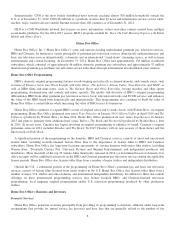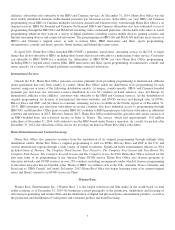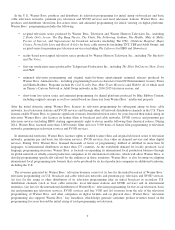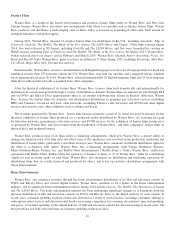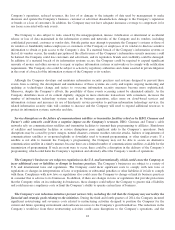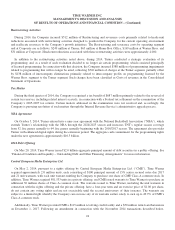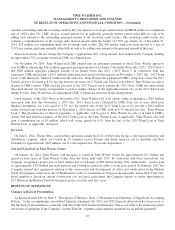Time Magazine 2014 Annual Report Download - page 31
Download and view the complete annual report
Please find page 31 of the 2014 Time Magazine annual report below. You can navigate through the pages in the report by either clicking on the pages listed below, or by using the keyword search tool below to find specific information within the annual report.Turner’s cable networks. If ratings decline significantly, Turner’s cable networks generally will be required to provide
additional advertising time to advertisers to reach agreed-on audience delivery thresholds. This may result in Turner’s cable
networks having less advertising time available to sell or to use to promote their own programming. Finally, if the television
ratings system is not changed so that it captures the viewership of Turner’s programming through digital video recorders,
VOD and mobile devices, advertisers may not be willing to pay advertising rates based on the increasing viewership that
occurs after the initial airing of a program and on digital platforms.
The Company’s results of operations may be adversely affected if the growth in digital sales of television content and
feature films do not exceed and offset the decline in physical disc sales. Several factors have contributed to an industry-
wide decline in sales of physical discs in recent years, including consumers shifting to SVOD services; consumers electing to
rent films using discount rental kiosks, which generate significantly less profit per transaction for the Company than the sale
of physical discs; changing retailer strategies and initiatives (e.g., reduction in floor space devoted to physical discs); retail
store closures; weak economic conditions; increasing competition for consumer discretionary time and spending; and piracy.
The Company’s efforts to offset the decline in sales of physical discs and to make digital ownership of content more
compelling to consumers (e.g., UltraViolet and EST) may not be successful or may take several more years to become
successful.
If the Company fails to compete successfully against alternative sources of entertainment and news, there may be an
adverse effect on the Company’s results of operations. The Company competes with all other sources of entertainment and
news, including television, premium pay television services, SVOD services, feature films, the Internet, home entertainment
products, videogames, social networking, print media, pirated content, live sports and other events, for consumers’ leisure
and entertainment time and discretionary spending. The number of media and entertainment choices available to consumers
has made it much more difficult to attract and obtain their attention and time. There can be no assurance that the Company
will be able to compete successfully in the future against existing or new competitors.
The Company is exposed to risks associated with weak domestic and global economic conditions and increased
volatility and disruption in the financial markets. The Company’s financial condition and results of operations may be
adversely affected by weak domestic and global economic conditions and the impact of those conditions on advertisers,
affiliates, suppliers, retailers, insurers, theater operators and others with which it does business. The global economy
continues to be volatile, with particular regions and countries, such as Argentina, Brazil, the Eurozone, India, Russia and
Venezuela, facing uncertain or slow economic growth. These conditions could lead to lower consumer spending for the
Company’s content and products in these regions and countries, particularly if advertisers, licensees, retailers, theater
operators and consumers reduce their demand for the Company’s content and products due to the negative impact of these
conditions on them. Consumer spending in these regions and countries may be further negatively impacted by governmental
actions to manage national economic matters, whether through austerity or stimulus measures or initiatives intended to
control wages, unemployment, credit availability, inflation, taxation and other economic drivers.
Increased volatility and disruptions in the financial markets could make it more difficult and more expensive for the
Company to refinance outstanding indebtedness and obtain new financing. In addition, the adoption of new statutes and
regulations, new interpretations of existing statutes and regulations or the enforcement of laws and regulations applicable to
the financial markets or the financial services industry could result in a reduction in the amount of available credit or an
increase in the cost of credit. Disruptions in the financial markets can also adversely affect the Company’s lenders, insurers
and counterparties, including vendors, retailers and film co-financing partners. The inability of the Company’s counterparties
to obtain capital on acceptable terms could impair their ability to perform under agreements with the Company and lead to
negative effects on the Company, including business disruptions, decreased revenues, increases in bad debt expenses and, in
the case of film co-financing partners, greater risk to the Company with respect to the performance of its feature films.
The Company faces risks relating to conducting business internationally that could adversely affect its businesses and
operating results. It is important for the Company to achieve sufficient scale in key international territories in a cost-
effective manner to be able to compete successfully in those territories. Failure to achieve sufficient scale could adversely
affect the Company’s results of operations. In addition, there are risks inherent in international business operations,
including:
• issues related to integrating and managing international operations and investments;
15



